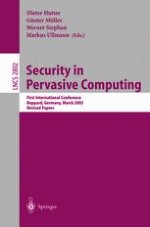2004 | Buch
Security in Pervasive Computing
First International Conference, Boppard, Germany, March 12-14, 2003. Revised Papers
herausgegeben von: Dieter Hutter, Günter Müller, Werner Stephan, Markus Ullmann
Verlag: Springer Berlin Heidelberg
Buchreihe : Lecture Notes in Computer Science
Enthalten in: Professional Book Archive
